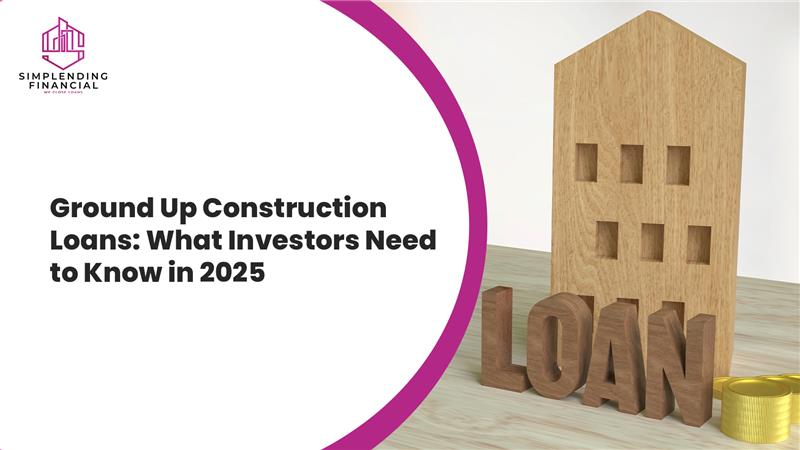Ground Up Construction Loans: What Investors Need to Know in 2025
31 Mar 2025
Posted By Admin
The United States real estate market is constantly changing, with investors looking more and more to ground up construction projects to get the most out of their investments. Whether you are a seasoned developer or a new investor, knowing about ground up construction loans is essential to financing new construction successfully. Moving into 2025, the lending environment is changing based on shifting economics, growing demand for housing, and the development of private lending solutions. This article covers all investors should understand regarding accessing ground up construction financing in 2025.
What Are Ground Up Construction Loans?
Ground up construction loans represent a form of short-term funding tailored to the construction of new properties from the ground up. Ground up construction loans are different from mortgages, which are employed for buying existing homes. Ground up construction loans, on the other hand, offer the financing needed for land purchases, material expenses, labor costs, and other construction-related expenses.
These loans will have draw schedule structures, by which money is disbursed incrementally as development occurs. Lenders track progress of the project to verify progress milestones are accomplished before releasing the next payment.
Why Ground Up Construction Loans Are Necessary for Investors
Investors prefer ground up construction financing since it has many benefits over alternative real estate finance options. The advantages include:
- Flexibility: Loans are tailored to the size of the project, enabling investors to finance housing, commercial developments, or mixed developments.
- Increased Profit Potential: By constructing from scratch, investors can build high-value assets that meet existing market requirements, resulting in improved returns.
- Managed Costs: As construction costs are planned and structured, investors retain greater control over project delivery and costs.
- Shorter Terms of Loans: Contrary to long-term mortgages, ground up construction loans are usually 12-24 months, which makes them perfect for projects with rapid turnaround.
Most Important Points Regarding Ground Up Construction Loans in 2025
1. Interest Rates and Market Trends
Interest levels vary in recent years, and 2025 is no different. Investors need to watch Federal Reserve policy, inflation rates, and the direction of lending to ascertain when to obtain financing. Private lenders can provide better rates than conventional banks, particularly for investors with excellent investment histories.
2. Loan Qualification Requirements
Lenders have set criteria for the approval of ground up construction loans. Investors are expected to fulfill the following requirements:
- Good Credit Profile: Credit score of at least 680 increases chances of approval.
- Thorough Construction Plan: Lenders expect a clear-cut blueprint, timeline, and cost estimate.
- Competent Builder or Contractor: Most lenders find it comfortable to deal with experienced builders who have successfully completed the same kind of projects.
- Down Payment: Investors are usually required to pay 20-30% of the project cost.
3. Selecting the Appropriate Lender
There are various kinds of lenders who provide ground up construction loans. These are:
- Traditional Banks: Provide lower interest rates but require more stringent qualification criteria and take longer to approve.
- Ground Up Construction Lenders: Private and hard money lenders focus on financing new construction ventures, providing quicker approvals and greater flexibility in terms.
- Government-Sponsored Programs: Certain state and federal programs assist new construction with grants or low-interest loans, but they usually have extra requirements.
4. Loan Disbursement Structure
Ground up construction loans are disbursed in stages according to project milestones. Typical draw schedules are:
- Land Acquisition: Funds for the acquisition of the property.
- Site Preparation & Foundation: Site clearing and foundation work.
- Framing & Roofing: Structural framing and roofing installation.
- Interior Work: Electrical, plumbing, and HVAC installation.
- Final Inspection & Completion: Final stage prior to issuance of certificate of occupancy.
Lenders make inspections at every stage to verify adherence to project plans prior to payment release.
5. Risk Management Strategies
Ground up construction projects are associated with possible risks, such as cost overruns, delay in construction, and market decline. In order to manage these risks:
- Work with Experienced Contractors: Employment of skilled professionals lowers the risk of project delay and poor workmanship.
- Have a Contingency Budget: It is essential to reserve 10-15% of the budget for surprise expenses.
- Secure Pre-Sales or Lease Agreements: Pre-selling or leasing out early secures a faster return on investment.
- Stay Informed on Market Trends: Local real estate demand and competition help make informed choices regarding location and property type.
The Future of Ground Up Construction Financing
Looking forward to 2025, ground up construction financing will change based on a number of considerations:
- Technological Changes: Online lending platforms are simplifying loan applications and approvals, opening up more financing options to investors.
- More Private Lending Options: Private lenders are increasing their offerings, meaning more possibilities for investors who cannot secure financing through a bank.
- Sustainability & Green Building Trends: Eco-friendly and energy-efficient construction projects are being incentivized by most lenders.
- Growing Demand for Housing: Urban growth and housing shortages in most cities make ground up construction an attractive investment option.


